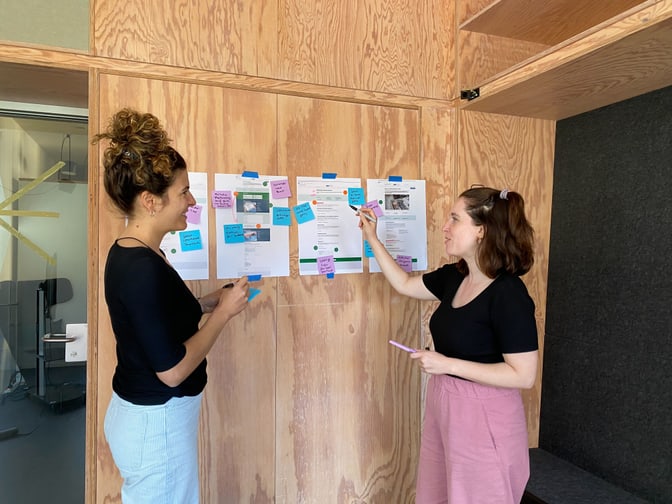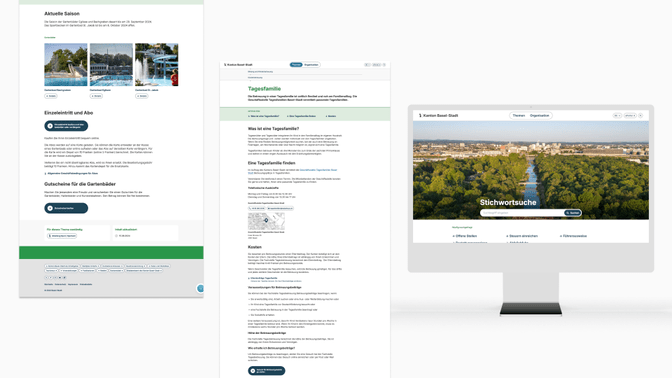The new website is designed to provide clear, compact information that meets the general public’s needs. The challenge: over 300 people are working on content for the canton of Basel-Stadt, which previously only had minimal guidelines and no interdepartmental strategy. We worked with the canton to develop a comprehensive, sustainable content strategy to initiate the change process. The content strategy serves as a shared compass for over 300 editors, who create the website’s content and provide long-term content management. Liip’s UX and content strategists worked hand in hand right from the start of the concept phase. We developed a user experience that would be helpful for both the website users and editors.
Product vision as the strategic basis
The website’s user focus and longevity are rooted in bs.ch’s product vision. We knew that the previous website was not yet meeting these needs. We, therefore, performed a qualitative content audit using a sample. This before-and-after comparison enabled us to show the future editorial team why the new content strategy and guidelines were necessary. Our key findings included overly complex language, outdated information and an inconsistent tone.

During the concept phase at the start of the project, we ran a joint workshop with the
department’s communications managers. The aim was to ensure acceptance of the interdepartmental content strategy – a new step for the canton. In the workshop, we developed the new tone and content goals for the website. The product vision served as our guiding North Star.
An editorial team with over 300 members
Our aim was to start creating content as quickly as possible. We revised or reformulated all of the content for the new website. We held a kick-off meeting with the editorial team in the canton’s council hall in the spring of 2023.
The website structure is now split into ‘topics’ and ‘organisation’. Under ‘topics’, users can see all the information they frequently search for and find typical administrative procedures without much prior knowledge. The content of these ‘topics’ is designed with a consistent interdepartmental, cross-unit approach. For this, we created editorial teams per topic, each with around 25 members. The editorial teams worked closely with Liip’s content strategists, from training to regular editorial meetings to individual sparring and feedback sessions. The remaining editors are responsible for the content relating to their departments and offices. They also attended training sessions and benefited from content feedback. However, our support was kept to a minimum. The departments also used the content strategy as a guide, but had more freedom, as the information in the ‘organisation’ section is less relevant for users. The ‘organisation’ section aims to allow the individual departments and offices to present themselves. We also make active communications (press releases and news) accessible. We trained a total of more than 300 people throughout the summer.
Editorial structure with numerous obstacles
We did not yet have a fully programmed CMS (content management system), which was a challenge. We provided tools to help the editorial team visualise the new content components and various page templates. We developed real content in clickable prototypes. We also created building kits in Figma, containing all available content components. This enabled the editorial team to produce content in Word, already thinking about how the content might later be implemented in the CMS.
Various functions are available to assist the editorial team in the CMS itself. Firstly, there is an editorial handbook with the content strategy, checklists, and tips for everyday editing work. Secondly, there is helpful content explaining the use cases for individual content components. The guidelines help the editorial team write and structure content in a consistent and user-friendly way.

Content governance: new roles, new processes
As there was no shared content strategy in the past, there were also few shared processes. Based on the content lifecycle model, we worked with the canton to develop viable content governance. Rather than just focusing on initial content creation, our processes incorporate the concept, creation, regular quality assurance, and even archiving. We challenged the content governance multiple times to ensure it was workable and adapted it to fit the editorial team’s needs.
Sustainable content quality
A new website is like a new home: to begin with, everything is tidy and in its proper place. However, as time passes, camping equipment piles up in the basement, and new furniture clutters up the corridor. We will also incorporate the content lifecycle into the CMS to keep the website useful and up-to-date in the long term. The system informs editors if content has not been updated for too long. This means they can check to ensure the content is still up-to-date and relevant.
Correct, up-to-date information is important not just for the general public, but also for the Alva chatbot, because the ‘cleaner’ we keep the content, the better the answers provided by the chatbot will be.

